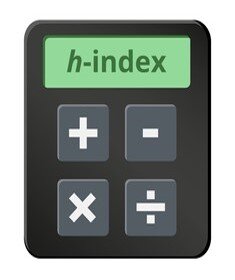کیفیه حساب معامل h-index یدویًا


فی هذا المقال، سنرشدک إلى کیفیه حساب معامل h-index یدویًا خطوه بخطوه. سنغطی موضوعات مثل فهم معامل h-index، جمع بیانات النشر والاستشهادات، ترتیب البیانات بترتیب تنازلی، وتحدید قیمه معامل h-index. بنهایه هذا المقال، ستتمکن من حساب معامل h-index الخاص بک یدویًا بدقه.

طوّر الفیزیائی خورخی إی. هیرش (Jorge E. Hirsch) معامل h-index فی عام 2005 لتقییم مساهمه الباحث الفردیه فی البحث العلمی. یعتمد هذا المؤشر على عدد المنشورات العلمیه ومستوى الاستشهادات التی حصل علیها کل منشور.
یُعتبر h-index مقیاسًا کمیًا یجمع بین الإنتاجیه البحثیه وتأثیر الاستشهادات، مما یوفر صوره أکثر شمولیه لتأثیر الباحث مقارنه بعدد المنشورات أو إجمالی الاستشهادات فقط.

لحساب معامل h-index یدویًا، یجب جمع بیانات حول منشوراتک وعدد الاستشهادات التی حصل علیها کل منها.
ابدأ بإعداد قائمه شامله بجمیع منشوراتک، بما فی ذلک المقالات العلمیه، أوراق المؤتمرات، فصول الکتب، وأی أعمال أکادیمیه أخرى.
حدد عدد الاستشهادات التی تلقاها کل منشور.
یمکنک العثور على هذه الإحصائیات من خلال قواعد بیانات مثل Google Scholar، Scopus، وWeb of Science.
تأکد من تسجیل أعداد الاستشهادات لکل منشور بدقه.

بعد جمع بیانات النشر والاستشهادات، قم بترتیب المنشورات ترتیبًا تنازلیًا وفقًا لعدد الاستشهادات.
أی أن المنشور الذی یحتوی على أعلى عدد من الاستشهادات یکون فی أعلى القائمه، یلیه المنشور ذو عدد الاستشهادات الأقل، وهکذا.
هذه الخطوه تساعد فی تحدید ترتیب المنشورات وفقًا لتأثیرها بناءً على عدد الاستشهادات التی حصلت علیها.

لحساب معامل h-index یدویًا، تحتاج إلى تحدید النقطه التی یتساوى فیها عدد الاستشهادات مع ترتیب المنشور.
ابدأ من أعلى القائمه، واحسب عدد المنشورات حتى تصل إلى نقطه یکون فیها عدد الاستشهادات مساویًا أو أقل من ترتیب المنشور.
أکبر رقم تتحقق فیه هذه القاعده هو معامل h-index الخاص بک.
مثال: إذا کان المنشور الخامس فی قائمتک یحتوی على 5 استشهادات أو أقل، فإن معامل h-index الخاص بک هو 4.

على الرغم من أن معامل h-index یوفر مقیاسًا مهمًا لتأثیر البحث، إلا أنه یحتوی على بعض القیود:
لا یأخذ فی الاعتبار جوده أو أهمیه المنشورات الفردیه، بل یعتمد فقط على عدد الاستشهادات.
قد تختلف أنماط الاستشهاد بین التخصصات المختلفه، مما قد یؤثر على دقه التقییم.
یمکن أن یتأثر معامل h-index بـ الاستشهادات الذاتیه أو أنماط التعاون بین الباحثین.
لذلک، یجب تحلیل معامل h-index إلى جانب مقاییس أخرى وتقییمات نوعیه للحصول على صوره متکامله حول تأثیر البحث العلمی.

الخلاصه
یتطلب حساب معامل h-index یدویًا جمع بیانات النشر والاستشهادات، ترتیبها تنازلیًا، ثم تحدید قیمه h-index بناءً على العلاقه بین عدد الاستشهادات وترتیب المنشور.
على الرغم من أن الطریقه الیدویه توفر فهمًا أساسیًا لکیفیه حساب h-index، إلا أن الأدوات وقواعد البیانات المؤتمته یمکن أن تسهل العملیه وتوفر نتائج أکثر دقه.
یجب اعتبار معامل h-index واحدًا فقط من بین العدید من المقاییس المستخدمه لتقییم تأثیر الأبحاث، ویجب تحلیله إلى جانب مؤشرات أخرى وتقییمات نوعیه.
أکادیمیه سیتا (SITA Academy)
تُعد أکادیمیه سیتا واحده من أبرز مقدمی الخدمات الأکادیمیه المتکامله لدعم الباحثین والأکادیمیین. نحن ندرک أهمیه تسهیل عملیه النشر فی المجلات العلمیه، ونساعد الباحثین فی کل مراحل النشر الأکادیمی.
خدماتنا تشمل
التحریر الأکادیمی باللغه الإنجلیزیه
یقدم فریقنا من المحررین المحترفین خدمات تحریر متخصصه لتحسین وضوح واتساق وجوده البحث العلمی.
نضمن التزام عملک بأعلى المعاییر اللغویه، مما یعزز قوه وأثر بحثک.
التنسیق وفق متطلبات المجلات العلمیه
نساعدک فی تنسیق المخطوطه وفقًا لمتطلبات المجله المستهدفه، بما فی ذلک تنسیق المراجع، العناوین، والتخطیط العام.
نضمن أن یکون البحث متناسقًا بصریًا وجاهزًا للنشر.
فحص السرقه الأدبیه (Plagiarism Checking)
نستخدم أحدث أدوات الکشف عن الانتحال لضمان أصاله البحث.
نساعدک فی التأکد من خلو البحث من الاقتباسات غیر الموثقه، مما یحسن فرص القبول فی المجلات المرموقه.
استخراج المقالات العلمیه من الرسائل الجامعیه
إذا کنت قد أکملت رساله ماجستیر أو دکتوراه وترید استخراج مقالات علمیه منها، یمکن لفریقنا مساعدتک فی إعداد بحث علمی جاهز للنشر استنادًا إلى أطروحتک.
مع أکادیمیه سیتا، نسعى إلى تبسیط وتسریع عملیه النشر الأکادیمی، مما یمنحک الوقت للترکیز على البحث العلمی بینما نتولى الجوانب الفنیه واللغویه.
تواصل معنا الیوم لمعرفه کیف یمکننا مساعدتک فی تحقیق أهدافک البحثیه ونشر أبحاثک فی مجلات مرموقه.
إذا کان لدیک أی أسئله، استفسارات، أو ترغب فی معرفه المزید عن خدماتنا، فلا تتردد فی التواصل معنا. فریقنا المخصص مستعد لمساعدتک.